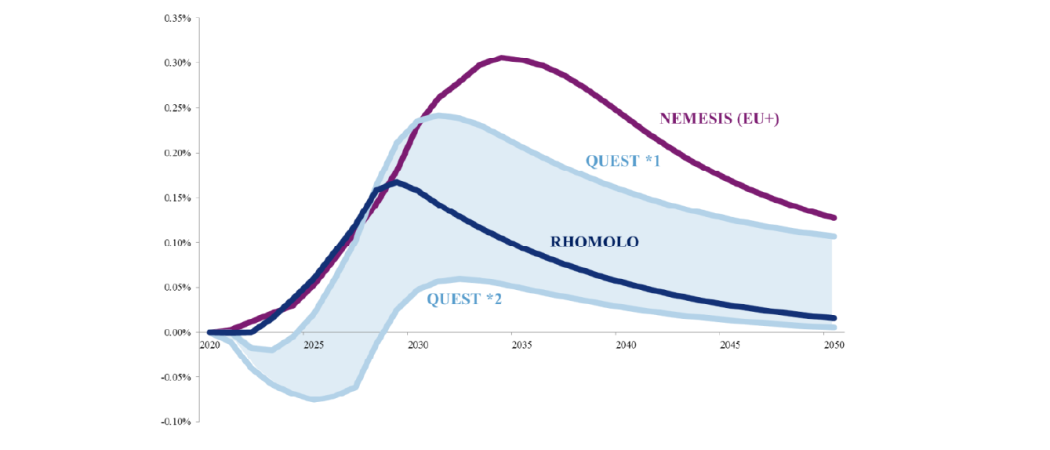EU economists forecast a positive economic impact from new research programme – but putting a precise number on it is difficult

The potential impact of Horizon Europe on the economy. Annual GDP growth rates could be boosted by as much as 0.31 percentage points, according to different EU economic models. Source: European Commission
Is Horizon Europe a good investment? Yes, say the European Commission’s economists – but how good depends on which economic model you want to play with.
According to an impact assessment of the €94.1 billion Horizon Europe plan the Commission published 7 June, the programme could stimulate an extra €800 billion to €975 billion in economic output over the next 25 years.
That would be accompanied by the creation of up to 100,000 R&D jobs during the seven-year programme, and more than 200,000 jobs in the rest of the economy after 2035, as the new products and services the programme stimulates start to be seen in the marketplace. In terms of gross domestic product, the various Commission models suggest, it works out to an annual average increase in growth rates of between 0.08 and 0.14 percentage points over the next 25 years.
Of course, this is all guesswork – albeit of a very fancy sort. Forecasting the impact of R&D is a notoriously difficult sub-section of economics, riddled with assumptions about how many products and services might result from the initial investments, and how widely or quickly they might be absorbed by companies, consumers and regions.
The Commission uses three different econometric models, each with different sets of assumptions – and private economists have many more models of their own. And because they are looking so far into the future, before anybody actually has an idea what these new services and products might be – it’s called “ex ante impact analysis” – the normal approximations of economics become even more wild.
‘The best one can do’
Still, said Luc Soete, former rector of the University of Maastricht and chair of an economic advisory committee to the Commission, “it is probably the best one can do and the results obtained must be reasonable.”
He added, “I think there is general agreement about the positive impact on growth and productivity of increased public R&D spending.”
Indeed, outside the Commission, the range of estimated economic impact of R&D is vast but generally upbeat. A typical figure, from recent research at the University of Manchester and the UK government, estimates an annual rate of return from public R&D investment of 20 per cent. A set of earlier studies in the US and Germany came up with a 28 per cent rate of return. By comparison, the yield on a 10-year US Treasury note is just short of 3 per cent.
The returns can be higher in tightly targeted programmes – if they are successful. For instance, one (much-disputed) study of the US Human Genome Project in the 1990s estimated that every dollar invested by Washington yielded more than $140 to the economy overall , in new cures, health services, a healthier workforce and much more. (For more details, see the Science|Business report: “Why fund research?”)
The Commission’s forecasts include some fairly conservative assumptions. For starters, when running the economic models, it assumed only a continuation of the current programme, Horizon 2020 – minus a 15 per cent contribution from the departing UK. In fact, the Commission on 7 June proposed a big budget increase, so presumably the real impact will be higher than its economists were assuming (they began work on the forecasts more than a year ago.)
The estimated impact also varies by region. In the current research programme, for instance, Cyprus, Hungary, Slovenia, Portugal and Estonia were the biggest recipients of a small pot of regional development aid; the Commission’s models suggested the annual impact in some regions could be as high as 0.18% of value added.
But it isn’t all great. Some of the Commission models also forecast a slight dip in output at the start of the programme – though in the long run it’s more than compensated by rising output. The reason is that the initial surge of grant money from Brussels could stimulate more hiring of researchers and engineers from other jobs, crimping labour supply and raising salaries for highly trained workers.





 A unique international forum for public research organisations and companies to connect their external engagement with strategic interests around their R&D system.
A unique international forum for public research organisations and companies to connect their external engagement with strategic interests around their R&D system.